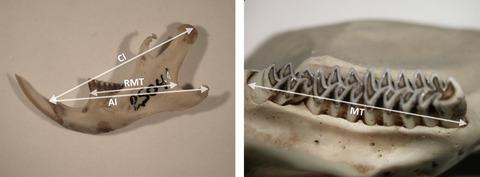Our official English website, www.x-mol.net, welcomes your
feedback! (Note: you will need to create a separate account there.)
Improving diet assessment of Arctic terrestrial predators with the size of rodent mandibles
Journal of Zoology ( IF 1.9 ) Pub Date : 2020-01-26 , DOI: 10.1111/jzo.12756 E. Schmidt 1 , D. Fauteux 1, 2 , J.‐F. Therrien 3 , G. Gauthier 2 , Y. Seyer 2
Journal of Zoology ( IF 1.9 ) Pub Date : 2020-01-26 , DOI: 10.1111/jzo.12756 E. Schmidt 1 , D. Fauteux 1, 2 , J.‐F. Therrien 3 , G. Gauthier 2 , Y. Seyer 2
Affiliation

|
Predator–prey interactions can control population fluctuations of several terrestrial vertebrates and energy fluxes in food webs. Quantifying these interactions typically requires the number of prey consumed by predators to be known, but prey size is often ignored. We hypothesized that rodent mandibles, which are routinely found in predatory bird pellets and mammalian scats, could be used to accurately determine prey size and thus estimate biomass consumed by Arctic predators. We used 1863 lemmings and voles from museum and field specimens collected across the North American Arctic to relate three measurements of the dentary bone and one on the molar toothrow with individual body mass. When species and location of specimens are known, our results suggest that the body mass of small rodents can be estimated with high precision using the dentary bone measurements (average R2 ranging from 0.73 to 0.81), especially for lemmings and Microtus voles. Body mass can also be estimated with reasonable precision using the dentary bone measurements even when species or location was unknown (0.71 ≤ R2 ≤ 0.80). Equations to convert mandible size to body mass are provided for site‐ and species‐specific estimations. Geographic variations in the relationship between mandible size and body mass were found, suggesting potential effects of genetic isolation or interactions with the immediate environment on size. Using mandible measurements in prey remains allows more precise estimation of biomass consumed by predators, which is essential to quantify energy fluxes within ecosystems and examine resource partitioning among Arctic predators.
中文翻译:

用啮齿动物下颌骨的大小改善北极陆生天敌的饮食评估
食肉动物与猎物之间的相互作用可以控制几种陆地脊椎动物的种群波动以及食物网中的能量通量。量化这些相互作用通常需要知道捕食者消耗的猎物数量,但是猎物的大小通常被忽略。我们假设啮齿动物的下颌骨(通常在掠食性鸟类的颗粒和哺乳动物的粪便中发现)可用于准确确定猎物的大小,从而估算北极捕食者消耗的生物量。我们使用了从北美洲北极地区收集的博物馆和野外标本中的1863年旅鼠和田鼠,将三种齿骨测量值和一种在磨牙牙龈上的测量值与个体体重相关联。知道标本的种类和位置后,[R 2范围从0.73至0.81),特别是对于旅鼠和田鼠田鼠。身体质量也可以与使用齿骨骨测量即使当物种或位置是未知的(合理精度0.71≤估计 - [R 2 ≤0.80)。提供了将下颌骨大小转换为体重的方程式,用于特定地点和特定物种的估计。下颌骨大小与体重之间关系的地理差异被发现,表明遗传隔离或与周围环境相互作用对大小的潜在影响。在猎物残骸中使用下颌骨的测量值可以更精确地估计捕食者消耗的生物量,这对于量化生态系统内的能量通量和检查北极捕食者之间的资源分配至关重要。
更新日期:2020-01-26
中文翻译:

用啮齿动物下颌骨的大小改善北极陆生天敌的饮食评估
食肉动物与猎物之间的相互作用可以控制几种陆地脊椎动物的种群波动以及食物网中的能量通量。量化这些相互作用通常需要知道捕食者消耗的猎物数量,但是猎物的大小通常被忽略。我们假设啮齿动物的下颌骨(通常在掠食性鸟类的颗粒和哺乳动物的粪便中发现)可用于准确确定猎物的大小,从而估算北极捕食者消耗的生物量。我们使用了从北美洲北极地区收集的博物馆和野外标本中的1863年旅鼠和田鼠,将三种齿骨测量值和一种在磨牙牙龈上的测量值与个体体重相关联。知道标本的种类和位置后,[R 2范围从0.73至0.81),特别是对于旅鼠和田鼠田鼠。身体质量也可以与使用齿骨骨测量即使当物种或位置是未知的(合理精度0.71≤估计 - [R 2 ≤0.80)。提供了将下颌骨大小转换为体重的方程式,用于特定地点和特定物种的估计。下颌骨大小与体重之间关系的地理差异被发现,表明遗传隔离或与周围环境相互作用对大小的潜在影响。在猎物残骸中使用下颌骨的测量值可以更精确地估计捕食者消耗的生物量,这对于量化生态系统内的能量通量和检查北极捕食者之间的资源分配至关重要。











































 京公网安备 11010802027423号
京公网安备 11010802027423号